#harvard glacier
Text
So, I went to check out Norway's Fjords and I also want out to Alaska, USA's fjords, and I'm not on the bandwagon like everone else who goes to Norway. They had to some really cool stuff there, but there are some thing that were kind of ... well read this and see if you agree with the differences between Norway and USA fjords. I think USA's fjords are highly underrated.
#alaska#Alaska Railroad#Anton Anderson Memorial Tunnel#cloudy#College Fjords#eagle#fjord#fjords#fog#foggy#Glacier Bay National Park and Preserve#Harbor. seals#harvard glacier#icebergs#Kenai Fjords National Park#mist#Norway#Puffin#sea gulls#Sea Otters#seals#seward#Seward Highway#Seward’s Foley#Seward's Folly#waterfalls#wildlife#Passport Bros#Black men
0 notes
Text
By Juan Cole
Common Dreams Opinion
Nov. 11, 2022
One of the issues that drove America's youth to vote in unusual numbers in the midterm elections, and to tilt heavily Democratic, is the climate emergency. It was up there with reproductive rights and gun safety as a key issue. A recent Harvard youth poll found that among these young people, "Democrats are moved by abortion (20%), protecting democracy (20%), inflation (19%), and climate change (16%). More than 7-in-10 young Americans (72%) believe that the rights of others are under attack, and 59% believe that their own rights are under attack."
According to a recent Blue Shield poll, some 75% of youth in America report that they have had panic attacks, depression, anxiety, stress and/or feelings of being overwhelmed when considering the issue of climate change.
Their feelings on the issues proved crucial, since many observers credit Gen Z with halting any red wave and with helping Biden emerge as the most successful president in the midterms in over 20 years.
Further, 63% of youth voted for Democrats, whereas only 35% voted Republican. Further, in one poll, 75% of youth said they are more likely to support a candidate for Congress who is "addressing climate change."
Where the climate implications of Biden's Inflation Reduction Act, which promotes green energy and green transportation, were explained to them 69% of younger voters said they would be more likely to vote for a congressman who voted for the IRA. They know of Biden's green energy commitments, but they apparently do not think they go far enough. The youth seem to like Biden's policies and those of the Democratic Party even though they don't particularly care for Biden himself (or only 44% do).
The catastrophe of the human-caused climate emergency is going to fall more heavily on Gen Z or the "Zoomers"– people born between 1997 and 2012. Even if we can get to zero carbon emissions by 2050, some changes are already in train that likely cannot be ameliorated for a very long time. These young people's lives will be harder and more challenging than those of their predecessors.
And they know it. According to a recent Blue Shield poll, some 75% of youth in America report that they have had panic attacks, depression, anxiety, stress and/or feelings of being overwhelmed when considering the issue of climate change. Globally, many of these young people are even afraid to bring children into the world that is being produced by our high-carbon styles of life.
A small Green 2.0 poll found that 89% of youth say that climate change has already had an impact on their lives and 44% said that it has had a major impact on their lives.
It will be hot in 2050, and some very large glaciers may melt under those conditions, causing the sea level to rise even more than the projected 4-5 feet. We are already seeing mega-droughts, heat waves, wildfires and massive flooding, so imagine how chaotic the climate will be in 30 years if we go on putting billions of tons of CO2 into the atmosphere annually for the next two decades.
The good news is that temperatures would immediately stop rising if we went to zero carbon dioxide emissions by 2050, according to climate models, and then over time the oceans would absorb most of the extra CO2 we have spewed into the atmosphere in the past century and a half. If we do this right, the earth will be on the road to less severe climate impacts a century from now. But as John Maynard Keynes pointed out, "in the long run" we are all dead. A century from now is too far off to do the Zoomers much good.
Still, this is an area of life where early action will produce better outcomes sooner than later action. So, Gen Z is impatient to cut down on carbon dioxide emissions.
The Blue Shield poll found that 45% of US youth say that they have tried to reduce electricity use. Most electricity in the US is still produced by burning coal or fossil gas, with only 25% of our electricity being generated by sustainable sources. Hence, the less electricity used, the fewer greenhouse gases are generated.
They know, however, that such individual actions are not enough and that government must act. 81% of youth in the Blue Shield poll said that global leaders are not doing enough to combat climate change.
Imagine how furious they are when they hear Republican politicians deny that humans burning fossil fuels is radically altering our climate! Moreover, they know exactly how to express their displeasure. They helped turn a lot of the rascals out of office.
Juan Cole
Juan Cole teaches Middle Eastern and South Asian history at the University of Michigan. His newest book, "Muhammad: Prophet of Peace Amid the Clash of Empires" was published in 2020. He is also the author of "The New Arabs: How the Millennial Generation Is Changing the Middle East" (2015) and "Napoleon's Egypt: Invading the Middle East" (2008). He has appeared widely on television, radio, and on op-ed pages as a commentator on Middle East affairs, and has a regular column at Salon.com. He has written, edited, or translated 14 books and has authored 60 journal articles.
9 notes
·
View notes
Text
80 mph speed record for glacier fracture helps reveal the physics of ice sheet collapse - Technology Org
New Post has been published on https://thedigitalinsider.com/80-mph-speed-record-for-glacier-fracture-helps-reveal-the-physics-of-ice-sheet-collapse-technology-org/
80 mph speed record for glacier fracture helps reveal the physics of ice sheet collapse - Technology Org
There’s enough water frozen in Greenland and Antarctic glaciers that global seas would rise by many feet if they melted. What will happen to these glaciers over the coming decades is the biggest unknown in the future of rising seas, partly because glacier fracture physics is not yet fully understood.
In this illustration, seawater flows deep below the surface into an actively opening ice shelf rift in Antarctica. New research shows that such rifts can open very quickly, and that the seawater rushing in helps control the speed of ice shelf breakage. Image credit: Rob Soto
A critical question is how warmer oceans might cause glaciers to break apart more quickly. University of Washington researchers have demonstrated the fastest-known large-scale breakage along an Antarctic ice shelf. The study, recently published in AGU Advances, shows that a 6.5-mile (10.5 kilometer) crack formed in 2012 on Pine Island Glacier — a retreating ice shelf that holds back the larger West Antarctic ice sheet — in about 5 and a half minutes. That means the rift opened at about 115 feet (35 meters) per second, or about 80 miles per hour.
“This is to our knowledge the fastest rift-opening event that’s ever been observed,” said lead author Stephanie Olinger, who did the work as part of her doctoral research at the UW and Harvard University and is now a postdoctoral researcher at Stanford University. “This shows that under certain circumstances, an ice shelf can shatter. It tells us we need to look out for this type of behavior in the future, and it informs how we might go about describing these fractures in large-scale ice sheet models.”
A rift is a crack that passes all the way through the roughly 1,000 feet (300 meters) of floating ice for a typical Antarctic ice shelf. These cracks are the precursor to ice shelf calving, in which large chunks of ice break off a glacier and fall into the sea. Such events happen often at Pine Island Glacier — the iceberg observed in the study has long since separated from the continent.
“Ice shelves exert a really important stabilizing influence on the rest of the Antarctic ice sheet. If an ice shelf breaks up, the glacier ice behind really speeds up,” Olinger said. “This rifting process is essentially how Antarctic ice shelves calve large icebergs.”
In other parts of Antarctica, rifts often develop over months or years. But it can happen more quickly in a fast-evolving landscape like Pine Island Glacier, where researchers believe the West Antarctic Ice Sheet has already passed a tipping point on its collapse into the ocean.
Satellite images provide ongoing observations. But orbiting satellites pass by each point on Earth only every three days. What happens during those three days is harder to pin down, especially in the dangerous landscape of a fragile Antarctic ice shelf.
Satellite images taken May 8 (left) and May 11 (right), three days apart in 2012, show a new crack that forms a “Y” branching off to the left of the previous rift. Three seismic instruments (black triangles) recorded vibrations that were used to calculate rift propagation speeds of up to 80 miles per hour.
For the new study, the researchers combined tools to understand the rift’s formation. They used seismic data recorded by instruments placed on the ice shelf by other researchers in 2012 with radar observations from satellites.
Glacier ice acts like a solid on short timescales, but it’s more like a viscous liquid on long timescales.
“Is rift formation more like glass breaking or like Silly Putty being pulled apart? That was the question,” Olinger said. “Our calculations for this event show that it’s a lot more like glass breaking.”
If the ice were a simple brittle material, it should have shattered even faster, Olinger said. Further investigation pointed to the role of seawater. Seawater in the rifts holds the space open against the inward forces of the glacier. And since seawater has viscosity, surface tension and mass, it can’t just instantly fill the void. Instead, the pace at which seawater fills the opening crack helps slow the rift’s spread.
“Before we can improve the performance of large-scale ice sheet models and projections of future sea-level rise, we have to have a good, physics-based understanding of the many different processes that influence ice shelf stability,” Olinger said.
Source: University of Washington
You can offer your link to a page which is relevant to the topic of this post.
#000#Antarctic#Antarctica#Behavior#Chemistry & materials science news#data#earth#Events#Forms#Fundamental physics news#Future#glaciers#Global#Greenland#how#ice sheet#iceberg#illustration#images#it#Landscape#Link#liquid#mass#material#ocean#ocean warming#oceans#Other#performance
0 notes
Text
SMART BOMB
The Completely Unnecessary News Analysis
By Christopher Smart
January 9, 2024
GOV. “SMILEYFACE” COX TRAMPLING OUT EVIL DIVERSITY
In a stunning and heroic reversal Utah Gov. Spencer “Smileyface” Cox came out against decency (DEI) because, he said, it's “bordering on EVIL.” The move is nothing short of brave because in years past he has hailed decency (DEI) as a way to bring people together. “It's about kindness and love for our fellow travelers.” But that was then — now he's calling for universities to “disempower DEI bureaucrats, responsible to no one, who have turned campuses to laughingstocks.” Laughingstocks for god's sake! This, of course, has nothing to do with the presidents of M.I.T., Harvard and University of Pennsylvania getting skinned alive before the special congressional inquisition regarding the blatant elitism of colleges and the DEI movement to put minorities and queers in charge of just about everything. The Republican Party is sick of pandering to people who advance only due to their female gender, color, and gender identity. Now, the GOP is trampling out the vintage where the grapes of wrath are stored. This DEI stuff is even worse than CRT (critical race theory), where small white children are taught to hate themselves. Sure, disemboweling people at televised congressional hearings is never pretty but we have an election coming up and a democracy to defend — at least until Trump is elected.
GET YOUR ASHES SPREAD ON THE MOON — FOR REAL
People can get hung up on where their ashes should be spread after cremation. Some folks just say things for conversation sake, like: “I want my ashes spread on Mr. Toad's Wild Ride at Disneyland.” Strangely enough, people really do get their ashes dumped at Disneyland. It requires something like an E Ticket. Other popular places folks get their ashes spread include Yellowstone, Glacier National Park and the Grand Canyon. And now — you guessed it — you can get you ashes spread or dumped, as the case may be, on the moon. United Launch Alliance in conjunction with Astrobotic are planning to launch ashes to the moon, despite objections from the Navajo Nation that it flies in the face of their spirituality. “Máíí’ Hosh,” as the moon is called in Navajo, is their spiritual guide and protector. The tribe has protested to NASA, but the space agency apparently has no jurisdiction over lunar ash spreading. Regulations seem to be sorely lacking up there. Imagine you're a Navajo and you seek guidance on your journey of self discovery only to look up and know that white man has messed everything up again. The CEO of the space-ashes project put it this way: “We do not and never have let religious beliefs dictate humanity's space efforts." Well, there goes the neighborhood.
VIDEO: GOD GAVE US TRUMP
God is looking down on the Earth as the video opens with this narration: "On June 14th, 1946, God looked down on his planned paradise and said, 'I need a caretaker.' So God gave us Trump." No Wilson, we are not making this up. It's something North Korean dictator Kim Jung Un would produce to remind his countrymen how great he is. "God said, 'I need someone to wake up before dawn, fix this country, work all day, fight the Marxists, eat supper, then go to the Oval Office and stay past midnight... So God made Trump." It could be a skit on Saturday Night Live. But this is no joke — it goes on for another 2 minutes and would make Moses blush. "I need someone… who can make money from the tar of the sand [and] turn liquid to gold.” At a rally in Madison City, Iowa, last week, God's caretaker said this: “I could tell you about the elevators on an [aircraft] carrier and they decided not to use hydraulic like the John Deere tractor, they decided to use magnets... to lift up the elevators with seven planes.” he said to the crowd. “Now all I know about magnets is this, give me a glass of water, let me drop it on the magnets, that’s the end of the magnets. Why didn’t they use John Deere... Do you like John Deere? I like John Deere.” God really does work in mysterious ways.
Post script — That's going to do it for another frigid week here at Smart Bomb where we keep track of the chill factor so you don't have to. Don't worry, spring is only four or five months away. Speaking of chilling, Republicans are very good at bending the English language to their benefit. “Tax and spend liberals.” “Let's go Brandon.” “Stop the Steal.” Here's are the newest words to go through the GOP's twisted connotation machine: diversity, equity and inclusion. Who could have predicted that “diversity” would become a nasty word. Of course, we've known for a long time that the Republican Party is not a hotbed of diversity. But now they're saying it out loud. It's the Civil Rights Movement in reverse. And their habitual projection seems to be at work: “DEI is just another name for racism.” Translation — if you support diversity you are a racist. Next we may see folks in white robes and conical hats burning crosses. Two steps forward and one step back. Or is it one step forward and two back. “This is the beginning of the end for DEI in America’s institutions,”said conservative activist Chris Rufo. Here at Smart Bomb we prefer a quote from Martin Luther King, Jr. “Nothing in the world is more dangerous than sincere ignorance and conscientious stupidity.”
Hey Wilson, how about you and the guys in the band serve up something upbeat that we can sing and dance to. You know, a nice, little ditty to put us in a good mood so we can face the rest of January. We've got the Wolf Moon coming up a little later this month, so take it away:
Well, it's a marvelous night for a Moondance
With the stars up above in your eyes
A fantabulous night to make romance
'Neath the cover of January skies
And all the leaves on the trees are falling
To the sound of the breezes that blow
And I'm trying to please to the calling
Of your heart-strings that play soft and low
And all the night's magic seems to whisper and hush
And all the soft moonlight seems to shine in your blush
Well, I wanna make love to you tonight
I can't wait 'til the morning has come
And I know that the time is just right
And straight into my arms you will run
And when you come my heart will be waiting
To make sure that you're never alone
There and then all my dreams will come true, dear
There and then I will make you my own
And every time I touch you, you just tremble inside
And I know how much you want me that you can't hide
One more Moondance with you in the moonlight
On a magic night
In the moonlight
On a magic night
Can't I just have one more dance with you my love
(Moondance — Van Morrison)
1 note
·
View note
Text
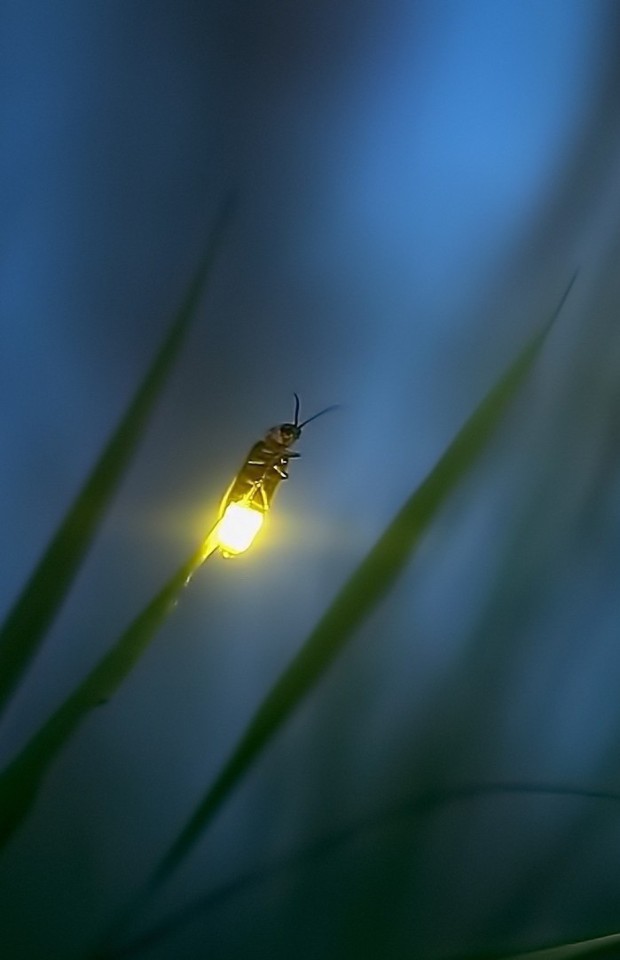
Morning Prayers: All Creatures
President Drew Faust’s Morning Prayers address in Appleton Chapel on September 16
THIS CHAPEL, this church represent places where we stop for a moment or an hour outside our usual work and lives to consider the larger meaning of what we do. It is also a place where we think beyond our own individual ambitions and achievements to reflect upon our obligations to one another and to a wider world.
Today I want to speak about one such obligation, one I am asking our community to take on with new focus and new force. It is an obligation to our children and to their children, and it is in one sense a quite simple matter of human self-interest and survival. But it is also a question with deeply spiritual implications concerning what we owe not just to one another and our descendants but to whatever god or transcendent being or divine force we might believe in. What I want to talk about today is the preservation of the world—its glaciers, its forests, its waterways, its species—in the face of the crisis of global warming and environmental change.
Among the most powerful memories of my childhood experiences in church and Sunday School are hymns that still echo in my mind. And a great many of those hymns are songs of praise and thanksgiving for creation’s wonders. “Fair are the meadows; fairer still the woodlands.” Or perhaps for me and so many others, most memorably:
All things bright and beautiful,
All creatures great and small,
All things wise and wonderful,
The Lord God made them all.
Each little flower that opens,
Each little bird that sings,
He made their glowing colors,
He made their tiny wings.
Written in 1848, the words to this hymn are steeped in Victorian romanticism, extolling the glowing colors of each little flower, the tiny wings of each little bird. Its rather treacly sentimentality and continuing popularity in a far more cynical age moved Monty Python to parody:
All things dull and ugly
All creatures short and squat
All things rude and nasty
The Lord God made the lot.
Each nasty little hornet,
Each beastly little squid
Who made the spiky urchin?
Who made the sharks? He did!
But Monty Python’s mockery actually reinforces, rather than rejects, my fundamental point: Urchins, squid, hornets, sharks matter too. They play an essential part in what we might call the wonders of biodiversity.
Yet we humans of the twenty-first century seem to be doing our best to destroy that wondrous creation. Pollution and climate change, habitat destruction and species extinction are growing threats to the world we have inherited and the world we will bequeath to our descendants—the creation we steward for purposes far larger than ourselves.
In July, I announced a new initiative for Harvard indicating that Harvard would be making an ambitious commitment to reducing its emission of greenhouse gases in an effort to lessen our carbon footprint and our contributions to global warming.* The goals we have set will not be easy to attain; they will require all of us to change assumptions and behavior, to live with enhanced consciousness and responsibility about our stewardship of the earth. And we will at the same time commit our intellectual resources as an institution devoted to learning and discovery, to explore policies and technologies that can make a significant difference in the crisis of sustainability that we face. In our work as students and scholars, in our lives as members of this community we must commit ourselves to preserving this wondrous creation all around us. However we may differ in our religious explanations and understandings, our lives are deeply intertwined and interdependent—with one another and with this world which we cannot permit to perish. To borrow words from the old hymn: We must be wise to preserve what is wonderful.
0 notes
Photo

I meant to make this rec post A G E S AGO so here it is, months and months late!
Winter’s Orbit by @avoliot aka Everina Maxwell
Prince Kiem, a famously disappointing minor royal and the Emperor's least favorite grandchild, has been called upon to be useful for once. He's commanded to fulfill an obligation of marriage to the representative of the Empire's newest and most rebellious vassal planet. His future husband, Count Jainan, is a widower...and murder suspect.
Neither wants to be wed, but with a conspiracy unfolding around them and the fate of the empire at stake they will have to navigate the thorns and barbs of court intrigue, the machinations of war, and the long shadows of Jainan's past, and they'll have to do it together.
So begins a legendary love story amid the stars.
If this sounds familiar it’s because this started as an already stunning OMC/OMC fic on ao3 called Course of Honor! YES THAT ONE! And now it is an EVEN MORE enthralling, entrancing, engaging piece of otherworldly fiction.
Do you love good writing? Miscommunication with good reason? I swear, this is best example I have ever read of two people talking at cross purposes, and it absolutely makes sense.
But most importantly, DO YOU LOVE SPACE BEARS WITH SCALES AND SIX LEGS?
I thought so.
Go read Winter’s Orbit.
#winter's orbit#avoliot#bookrecs#also#alaska: we're cool#this is harvard glacier btw! and yes i brought a book on a glacier tour#i live here i'm allowed
30 notes
·
View notes
Photo

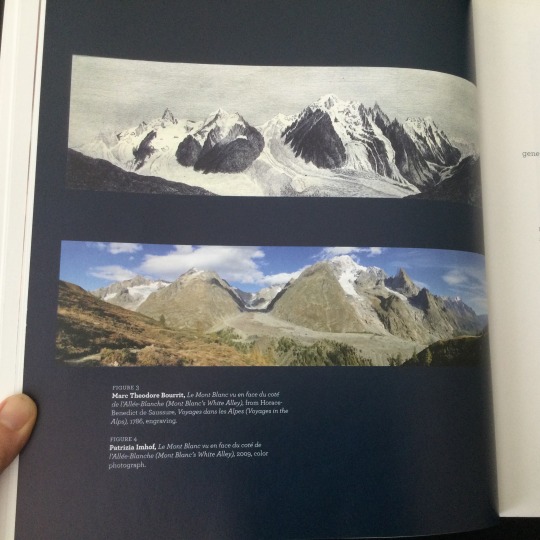

“The ice and the long moonlit polar nights, with all their yearning,
seemed like a far-off dream from another world—
a dream that had come and passed away.
But what would life be worth without its dreams?
- Fridtjof Nansen, “Farthest North,” 1897
This publication introduces the artistic legacy of the planet's frozen frontiers now threatened by a changing climate. Tracing the impact of glaciers, icebergs, and fields of ice on artists' imaginations, “Vanishing Ice” explores the connections between generations of artists who have adopted different styles, media, and approaches to interpret alpine and polar landscapes.
Image 1: Front cover with image by Jean de Pomereu, “Fissure 2 (Antarctica)” from Sans Nom, 2008, archival inkjet print.
Description: A fissure on the ice showing the dark water underneath
Image 2. Top: Marc Theodore Bourrit, “Le Mont Blanc vu en face du coté de l’Allée-Blanche,” from Horace-Benedict de Saussure, Voyages dans les Allpes, 1786, engraving.
Bottom: Patrizia Imhof, Le Mont Blanc vu en face du coté de, l’Allée-Blanche, 2009, color photograph
Description: Two photographs showing the difference in the amount of ice and snow on Mont Blanc. Top image from 1786 shows a lot more amount of ice and snow covering the mountains. Bottom image shows very little snow on top of the mountains.
Image 3: Francois-Auguste Biard, Pêche au morse par des Groënlandais, vue de l’Océan Glacial (Greenlanders hunting walrus, view of the Polar Sea), Salon of 1841, oil on canvas.
Description: A couple of fishing boats with fishermen in the foreground, surrounded by a number of large icebergs in the rough sea.
Vanishing ice : alpine and polar landscapes in art, 1775-2012
Matilsky, Barbara C. [author]
1st ed.
Bellingham, Wash. : The Whatcom Museum ; Seattle, Wash. : Distributed by the University of Washington Press, 2013.
144 p. : col. ill. ; 28 cm.
Language: English
"This publication accompanies the touring exhibition, Vanishing ice : alpine and polar landscapes in art, 1775-2012, for the Whatcom Museum ... Whatcom Museum, Bellingham, Washington, November 2, 2013-March 2, 2014; El Paso Museum of Art, El Paso, Texas, June 1-August 24, 2014; McMichael Canadian Art Collection, Kleinberg, Ontario, October 11, 2014-January 11, 2015"
2013
HOLLIS number: 990138118670203941
#vanishingice#ice#icemelting#climatechange#environment#glaciers#icebergs#snow#polarlandscape#fineartslibrary#harvardfineartslibrary#Harvard#harvard library#harvardlibrary#montblanc#polarsea#Greenland
13 notes
·
View notes
Photo
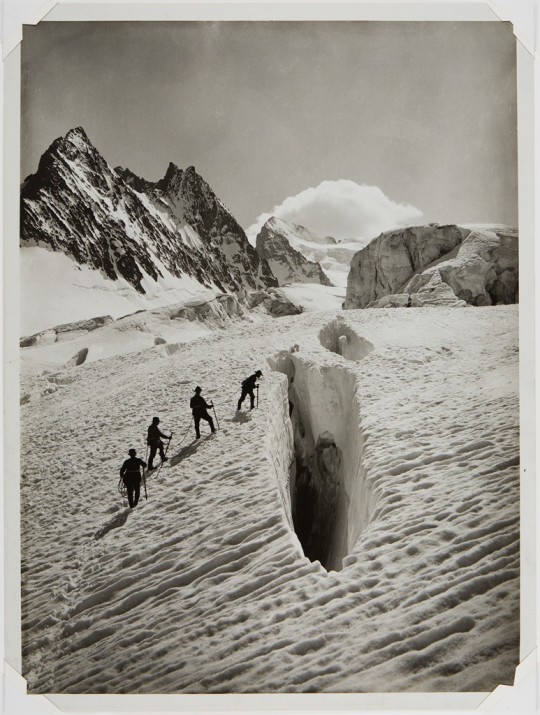
On the Glacier Blanc, in the Dauphiny, Vittorio Sella, c. 1885, Harvard Art Museums: Photographs
Harvard Art Museums/Fogg Museum, Transfer from the Carpenter Center for the Visual Arts
Size: image: 37.8 x 27.9 cm (14 7/8 x 11 in.) sheet: 39.7 x 29.7 cm (15 5/8 x 11 11/16 in.)
https://www.harvardartmuseums.org/collections/object/158101
50 notes
·
View notes
Photo
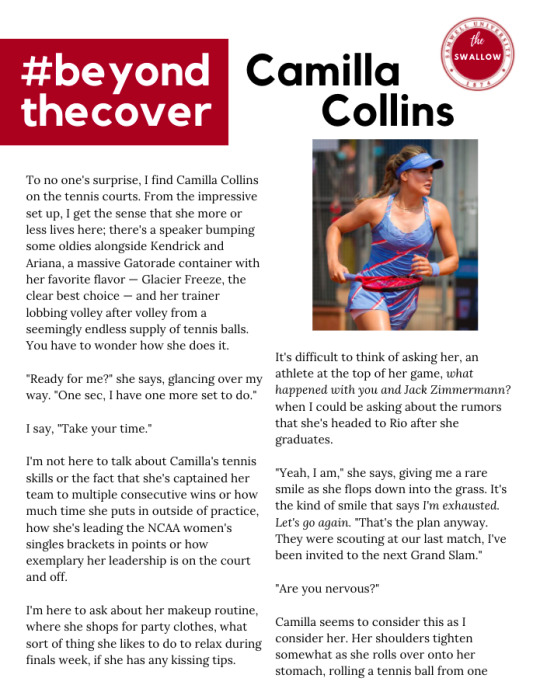

Join us for an exclusive interview with the woman on this issue’s cover, SWT’s very own Camilla Collins!
[fancast: Canadian tennis player Genie Bouchard]
For ease of reading, this interview has been transcribed under the cut.
To no one's surprise, I find Camilla Collins on the tennis courts. From the impressive set up, I get the sense that she more or less lives here; there's a speaker bumping some oldies alongside Kendrick and Ariana, a massive Gatorade container with her favorite flavor — Glacier Freeze, the clear best choice — and her trainer lobbing volley after volley from a seemingly endless supply of tennis balls. You have to wonder how she does it.
"Ready for me?" she says, glancing over my way. "One sec, I have one more set to do."
I say, "Take your time."
I'm not here to talk about Camilla's tennis skills or the fact that she's captained her team to multiple consecutive wins or how much time she puts in outside of practice, how she's leading the NCAA women's singles brackets in points or how exemplary her leadership is on the court and off.
I'm here to ask about her makeup routine, where she shops for party clothes, what sort of thing she likes to do to relax during finals week, if she has any kissing tips.
It's difficult to think of asking her, an athlete at the top of her game, what happened with you and Jack Zimmermann? when I could be asking about the rumors that she's headed to Rio after she graduates.
"Yeah, I am," she says, giving me a rare smile as she flops down into the grass. It's the kind of smile that says I'm exhausted. Let's go again. "That's the plan anyway. They were scouting at our last match, I've been invited to the next Grand Slam."
"Are you nervous?"
Camilla seems to consider this as I consider her. Her shoulders tighten somewhat as she rolls over onto her stomach, rolling a tennis ball from one hand to another. She does it like she loves it.
I'm not at all surprised when she says, "Yeah, honestly. But I wanna know, you know? I wanna see where I line up. My parents always told me that if I failed, might as well fail big so it'll be easier next time. How much bigger can it get than the Olympics?"
"Do you think you're gonna fail?"
"Oh, no." She laughs. "I think I'm gonna smash it. But you can't play like you think you'll win no matter what. You have to stay hungry for it."
"How do you stay hungry?"
Camilla shrugs. "There's always another step to this game, another challenge. Every new match is like learning how to dance. You learn to think on your feet and improvise and then, hopefully, you take those steps into your next match, and maybe you stumble here and there but you keep the rhythm."
We spend a few moments talking about her upcoming match against Harvard and what she's focusing on in training and at the end of our time, Camilla juggles a ball on her racket and says, "Thank you."
"What for?" I ask, surprised.
"Keeping this about my achievements instead of whoever I'm hooking up with. It's a nice change." She gives me the half smile she's so well known for. "If it's just us, though ... I'm still human. And there's plenty to say off the record."
I leave a few hours later. When I look back, Camilla Collins is back on the court. She's dancing.
__________________
Camilla Collins is an athlete, a dancer, and future Olympic gold medalist. It's Camilla's world; the rest of us are just living in it.
#camilla collins#omgcheckplease#the samwell swallow#beyond the cover#50 most beautiful#hard hitting journalism#interviews
142 notes
·
View notes
Photo

View of Aletsch Glacier, John Singer Sargent, c. 1871-1872, Harvard Art Museums: Drawings
Top edge uneven. Harvard Art Museums/Fogg Museum, Gift of Mrs. Francis Ormond
Size: actual: 38.9 x 27.1 cm (15 5/16 x 10 11/16 in.)
Medium: Graphite on off-white wove paper
https://www.harvardartmuseums.org/collections/object/310191
7 notes
·
View notes
Photo

The Glacier of Tacconnay, No. 1, George Baxter, 19th century, Harvard Art Museums: Prints
Harvard Art Museums/Fogg Museum, Gift of Charles H. Taylor
https://www.harvardartmuseums.org/collections/object/257714
2 notes
·
View notes
Quote
Ask medieval historian Michael McCormick what year was the worst to be alive, and he's got an answer: "536." Not 1349, when the Black Death wiped out half of Europe. Not 1918, when the flu killed 50 million to 100 million people, mostly young adults. But 536. In Europe, "It was the beginning of one of the worst periods to be alive, if not the worst year," says McCormick, a historian and archaeologist who chairs the Harvard University Initiative for the Science of the Human Past.
A mysterious fog plunged Europe, the Middle East, and parts of Asia into darkness, day and night—for 18 months. "For the sun gave forth its light without brightness, like the moon, during the whole year," wrote Byzantine historian Procopius. Temperatures in the summer of 536 fell 1.5°C to 2.5°C, initiating the coldest decade in the past 2300 years. Snow fell that summer in China; crops failed; people starved. The Irish chronicles record "a failure of bread from the years 536–539." Then, in 541, bubonic plague struck the Roman port of Pelusium, in Egypt. What came to be called the Plague of Justinian spread rapidly, wiping out one-third to one-half of the population of the eastern Roman Empire and hastening its collapse, McCormick says.
Historians have long known that the middle of the sixth century was a dark hour in what used to be called the Dark Ages, but the source of the mysterious clouds has long been a puzzle. Now, an ultraprecise analysis of ice from a Swiss glacier by a team led by McCormick and glaciologist Paul Mayewski at the Climate Change Institute of The University of Maine (UM) in Orono has fingered a culprit. At a workshop at Harvard this week, the team reported that a cataclysmic volcanic eruption in Iceland spewed ash across the Northern Hemisphere early in 536. Two other massive eruptions followed, in 540 and 547. The repeated blows, followed by plague, plunged Europe into economic stagnation that lasted until 640, when another signal in the ice—a spike in airborne lead—marks a resurgence of silver mining, as the team reports in Antiquity this week.
“Why 536 was the worst year to be alive” from Science magazine
18K notes
·
View notes
Link
Ask medieval historian Michael McCormick what year was the worst to be alive, and he's got an answer: "536." Not 1349, when the Black Death wiped out half of Europe. Not 1918, when the flu killed 50 million to 100 million people, mostly young adults. But 536. In Europe, "It was the beginning of one of the worst periods to be alive, if not the worst year," says McCormick, a historian and archaeologist who chairs the Harvard University Initiative for the Science of the Human Past.
A mysterious fog plunged Europe, the Middle East, and parts of Asia into darkness, day and night—for 18 months. "For the sun gave forth its light without brightness, like the moon, during the whole year," wrote Byzantine historian Procopius. Temperatures in the summer of 536 fell 1.5°C to 2.5°C, initiating the coldest decade in the past 2300 years. Snow fell that summer in China; crops failed; people starved. The Irish chronicles record "a failure of bread from the years 536–539." Then, in 541, bubonic plague struck the Roman port of Pelusium, in Egypt. What came to be called the Plague of Justinian spread rapidly, wiping out one-third to one-half of the population of the eastern Roman Empire and hastening its collapse, McCormick says.
Historians have long known that the middle of the sixth century was a dark hour in what used to be called the Dark Ages, but the source of the mysterious clouds has long been a puzzle. Now, an ultraprecise analysis of ice from a Swiss glacier by a team led by McCormick and glaciologist Paul Mayewski at the Climate Change Institute of The University of Maine (UM) in Orono has fingered a culprit. At a workshop at Harvard this week, the team reported that a cataclysmic volcanic eruption in Iceland spewed ash across the Northern Hemisphere early in 536. Two other massive eruptions followed, in 540 and 547. The repeated blows, followed by plague, plunged Europe into economic stagnation that lasted until 640, when another signal in the ice—a spike in airborne lead—marks a resurgence of silver mining, as the team reports in Antiquity this week.
15 notes
·
View notes
Photo
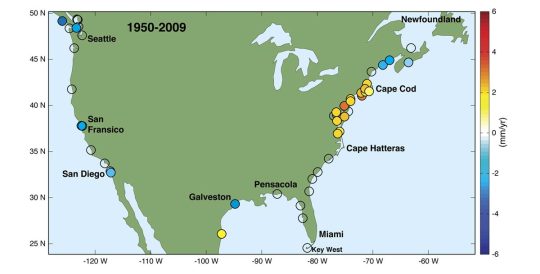
Local Sea Level Rise- one of the trickiest predictions.
In my last post (http://on.fb.me/1advPiu) I mentioned that sea level rise from Antarctica melting would not be distributed equally throughout the globe, and in the coming posts I'll explain why. Currently, most of sea level rise is due to thermal expansion caused by warming of the oceans, the remainder coming from melting ice and reduction of liquid water storage on land. In the latest IPCC report, it has been suggested that sea level may rise up to a meter by 2100. This prediction is assuming that Antarctic Ice Shelves remain stable, which may not be the case (see our previous post: http://on.fb.me/1yuE5jq). The latest IPCC report has also predicted that it is very likely that over 95% of the world’s ocean surface will rise...but what about the other 5%? Those surfaces are most likely near current and former glaciers and ice sheets. Sea level rise will be experienced very differently in different parts of the world, with deviations up to 50% from the global mean sea level projection.
Antarctica and Greenland hold the vast majority of earths freshwater and are also contributors to sea level rise. A common belief is that melting of these vast ice caps would result in uniform sea level rise. This is not the case – models have shown that such melting can actually cause a decrease in relative sea level around these regions. There are two main reasons behind this; the first one is gravity.
These ice caps (Antarctica especially) are so massive that their gravitational force pulls water towards them, much like the moon does with the ocean. This effect results in sea levels higher than they would be otherwise for thousands of kilometers around them, which means lower sea levels elsewhere. As they shrink, their gravitational pull weakens, which also lessens their hold on the surrounding water which leads to higher sea levels elsewhere.
To put some numbers on this, a researcher from Harvard calculated that if the entire West Antarctic Ice Sheet collapsed and melted, the global mean sea level rise would be up to 5m, however it would be approximately 6.5m in various cities in the USA, and less in other areas. The image depicts findings from a 2012 paper by Sallenger and others, showing the distribution of sea level rise across the United States of America.
-MJA
Image credit: Sallenger et al., 2012.
Further reading/references: IPCC on sea level rise: http://bit.ly/1CrvtOk
http://bit.ly/1CrvtOk
http://bit.ly/1nddrec
Sallenger Jr, A. H., Doran, K. S., & Howd, P. A. (2012). Hotspot of accelerated sea-level rise on the Atlantic coast of North America. Nature Climate Change, 2(12), 884-888.[_
_](https://www.facebook.com/TheEarthStory/photos/a.352867368107647/856257781101934/?type=1&theater#)
88 notes
·
View notes
Text
Berikut 10 Gunung Tertinggi yang ada di Benua Amerika yang Menjadi Tujuan Para Pendaki
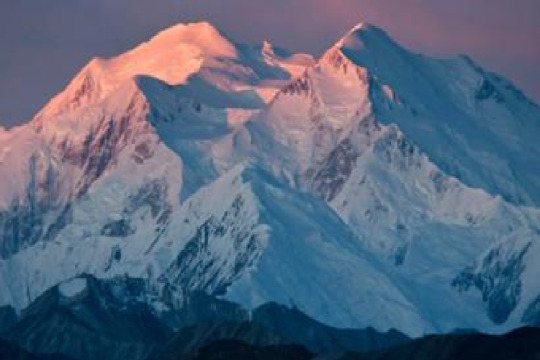
Berikut 10 Gunung Tertinggi yang ada di Benua Amerika yang Menjadi Tujuan Para Pendaki - Anda datang ke sini untuk membaca ikhtisar dari gunung-gunung tertinggi di Amerika Utara karena, berlawanan dengan apa yang siklus siklus berita Anda yakini, sebenarnya ada jauh lebih banyak hal di benua besar, bergunung-gunung ini daripada Presiden Amerika Serikat yang tidak kompeten. . Maka, tanpa basa-basi lagi, mengalahkan semua yang lain di daftar 'gunung tertinggi di Amerika Utara' adalah Denali yang sebelumnya dikenal sebagai Gunung McKinley dan secara resmi bagian dari Tujuh Puncak yang terkenal.
Gunung Denali
Dikenal luas sebagai Gunung McKinley setelah seorang pencari emas menamakannya demikian pada tahun 1896 sebagai cara untuk menunjukkan dukungan bagi kandidat presiden saat itu William McKinley, nama itu bertentangan dengan gelar asli gunung Denali yang diberikan kepadanya oleh orang-orang Koyukon asli. Pada tahun 1917, pemerintah federal secara resmi mengakui nama Gunung McKinley sebagai gunung. Nama ini bertahan hingga 2015, di mana pemerintahan Obama mengumumkan perubahan kembali ke nama asli Denali yang dikenal sebagai hari ini.
Gunung Logan
Kedua dalam daftar dan gunung tertinggi di Kanada, Gunung Logan berada hanya 40 kilometer di utara perbatasan Kanada Alaska. Itu adalah binatang gunung yang sesungguhnya, menempati posisi keenam di puncak dunia yang paling menonjol. Itu juga dianggap memiliki salah satu lingkaran dasar terbesar dari salah satu gunung non-vulkanik di bumi. Sementara ketinggian 5.959 meter telah ditetapkan, Gunung Logan masih naik tinggi, karena aktivitas tektonik di bawah ini. Bahkan sebelum tahun 1992, ketinggian pasti Gunung Logan belum dikonfirmasi.
Pico De Orizaba
Gunung tertinggi di Meksiko, Pico de Orizaba adalah stratovolcano yang tidak aktif dan merupakan puncak gunung berapi tertinggi kedua di dunia di belakang gunung tertinggi Kilimanjaro Afrika. Pico de Orizaba terlihat oleh kapal-kapal yang mendekati pelabuhan Veracruz. Ini adalah salah satu dari tiga gunung berapi di dunia yang masih memiliki gletser. Salah satu gletser di Pico de Orizaba, Gran Glacier Norte, adalah gletser terbesar di Meksiko (ada delapan gletser lain yang dikenal di gunung berapi).
Gunung Saint Elias
Saat berada di antara perbatasan Alaska Kanada, Gunung Saint Elias adalah gunung tertinggi kedua di Amerika Serikat dan Kanada dan paling terkenal karena bantuan vertikalnya. Pendakian pertama dilakukan pada tahun 1897 oleh sebuah ekspedisi yang dipimpin oleh Duke of the Abruzzi, yang juga mencoba mendaki di Afrika dan di K2 (gunung tertinggi kedua di dunia dan juga salah satu yang paling mematikan). Setelah ekspedisi 1897, itu tidak sampai 1946 sebelum kita melihat pendakian kedua yang dilakukan oleh Harvard Mountaineering Club.
Popocatépetl
Lihatlah barat daya Mexico City pada hari yang cerah dan Anda akan dapat melihat stratovolcano dari Popocatépetl, puncak tertinggi kelima di Amerika Utara dan puncak tertinggi kedua di Meksiko. Sama seperti gunung berapi yang lebih besar dalam daftar ini, Pico de Orizaba, Popocatépetl juga mengadakan gletser di sisi puncaknya. Namun, karena peningkatan aktivitas vulkanik, gletser-gletser ini dengan cepat mundur antara 1990 dan 2001 ke titik di mana semua gletser mencair.
Gunung Foraker
Mereka yang ingin menghabiskan tiga minggu dalam ekspedisi untuk mendaki Denali (tertinggi dalam putaran ini) akan menghabiskan waktu di base camp Denali yang terletak di Gletser Kahiltna. Berdiri di atas basecamp ini adalah puncak 5.304 meter dari Mount Foraker. Mount Foraker pertama kali dinaiki oleh Charles Huston dan Graham Brown. Houston lahir di New York dan mendaki secara luas di seluruh dunia, memimpin rute ke banyak puncak di Himalaya. Houston juga terkenal karena menjadi salah satu orang Barat pertama yang masuk ke sisi Nepal Everest dan memimpin ekspedisi ke atas air terjun Khumbu yang membuka jalan bagi Edmund Hillary untuk mencapai puncak gunung tertinggi di dunia.
Gunung Lucania
Ketika ia berdiri di puncak puncak tertinggi keempat dalam daftar ini, Gunung Saint Elias, Adipati Abruzzi menamai puncak yang bisa dilihatnya di kejauhan. Dia menamai puncak ini Gunung Lucania, setelah kapal yang dia dan tim ekspedisinya berlayar dari Liverpool ke New York menggunakan RMS Lucania. Menggunakan pesawat salju untuk mencapai titik tertinggi 2.670 meter di Gletser Walsh di dekatnya, pendakian pertama Gunung Lucania dilakukan oleh pendaki gunung Amerika, Bradford Washburn dan Robert Hicks.
Iztaccihuatl
Gunung berapi 450 km3 ini merupakan rangkaian kerucut yang terhubung dari mana puncaknya dinamai. Iztaccihuatl berarti "Perempuan Kulit Putih" dalam Nahuatl judul yang diberikan kepadanya karena serangkaian puncak dikatakan menyerupai kepala, dada, lutut, dan kaki seorang wanita yang tidur. Meskipun pendakian pertama yang dicatat dari Iztaccihuatl dilakukan pada tahun 1889, bukti arkeologis menunjukkan bahwa suku Aztec dan peradaban sebelumnya bisa memanjat gunung berapi sebelum ini.
King Peak
Jangan bingung dengan puncak tertinggi di negara bagian Utah Kings Peak yang berada di ketinggian lebih rendah 4.123 meter. King Peak ditemukan di Yukon Kanada dan naik ke 5.173 meter di atas permukaan laut, menjadikannya gunung tertinggi keempat di Kanada dan kesembilan di benua Amerika Utara. Meskipun puncak ini berada di urutan kedua dari bawah pada 10 besar ini, pendakian pertama tidak benar-benar dilakukan sampai tahun 1952 oleh mahasiswa dari Universitas Alaska. Pendakian yang relatif terlambat ini sebagian besar turun ke lereng curam yang mengapit puncak, lereng curam yang membuat kondisi pendakian yang rumit.
Gunung Steele
Dinamai setelah Sir Sam Steele, perwira polisi tingkat tinggi yang bertanggung jawab atas pasukan Yukon selama Demam Emas Klondike, ketika sekitar 100.000 calon pelanggan bermigrasi ke wilayah Klondike di Yukon dengan harapan menemukan emas dan membuat kekayaan mereka. Gunung Steele masuk ke daftar gunung tertinggi di Amerika Utara ini dengan ketinggian 5.073 meter. Pendakian pertama Gunung Steele ini dilakukan secara spektakuler setelah satu meter salju baru dibuang ke gunung, memaksa banyak ekspedisi untuk merangkak melintasi dataran tinggi puncak ke puncak.
#GUNUNG TERTINGGI BENUA AMERIKA#GUNUNG DENALI#GUNUNG LOGAN#GUNUNG SAINT ELIAS#GUNUNG FORAKER#GUNUNG LUCANIA#GUNUNG STEELE
1 note
·
View note
Text
Lake McDonald Montana Jigsaw Puzzle
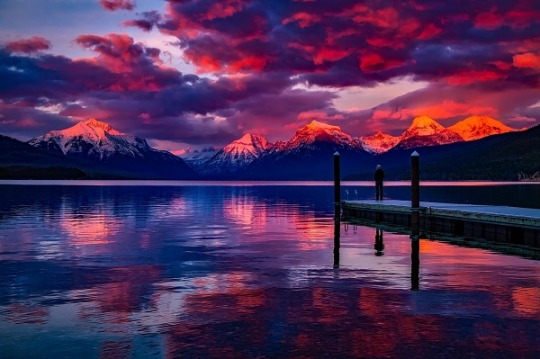
Click Here To Work Puzzle
Lake McDonald is the largest lake in Glacier National Park. It is approximately 10 miles long and over a mile wide and has a depth of 472 feet. Here’s a video cam showing the lake. Webcam Map Link
1,911 Live In Montana with Multiple Sclerosis, as of 10/2016
Multiple Sclerosis (MS) is the most common neurological disease among young adults, typically appearing between the ages of 20 and 40. Over 400,000 Americans suffer from MS. More than 200 new patients are diagnosed each week and more women are affected than men. – Harvard NuroDiscovery

Use of this photo does not constitute any endorsement or connection to Wipe Out MS by either The National MS Society or the photo creator.
Image by David Mark from Pixabay
1 note
·
View note